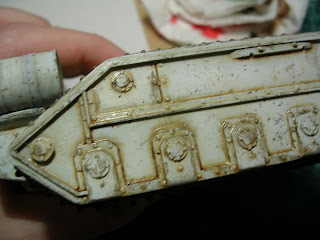(versión en Español)
If there is a piece from GW I do not like at all, it's the tow cable from the Imperial vehicle accesory sprue.
Here it is a simple way to do your own realistic tow cables, and in nearly no time.
You'll need copper or other metallic wire. I have been so lucky to have access to a power cable with fairly thick copper strands.
If there is a piece from GW I do not like at all, it's the tow cable from the Imperial vehicle accesory sprue.
Here it is a simple way to do your own realistic tow cables, and in nearly no time.
You'll need copper or other metallic wire. I have been so lucky to have access to a power cable with fairly thick copper strands.
 I take five copper strands from the cable.
I take five copper strands from the cable. I twist one end with a plier.
I twist one end with a plier. I'll use a chuck to clamp the other end.
I'll use a chuck to clamp the other end. I will use my trusty low speed IXO to twist the copper wires.
I will use my trusty low speed IXO to twist the copper wires. I firmly hold the free end with the pliers.
I firmly hold the free end with the pliers. And start twisting the wires.
And start twisting the wires. I stop once I feel the cable is twisted enough.
I stop once I feel the cable is twisted enough. I cut the ends...
I cut the ends... Now I make a loop at the ends.
Now I make a loop at the ends. Like this:
Like this: Now I take a lenght of cable plastic cover.
Now I take a lenght of cable plastic cover. And cut it lenghtwise by half.
And cut it lenghtwise by half. I put one half inside the loop, cutting the excess.
I put one half inside the loop, cutting the excess. Now I glue it with cyanocrilate.
Now I glue it with cyanocrilate. I use more copper wire to close the loop.
I use more copper wire to close the loop. The finished loop. You can wrap the wire we have added now with a tin strip if you want a better finishing.
The finished loop. You can wrap the wire we have added now with a tin strip if you want a better finishing. The finished cable.
The finished cable. This is how it looks once it is glued on the model.
This is how it looks once it is glued on the model.








































